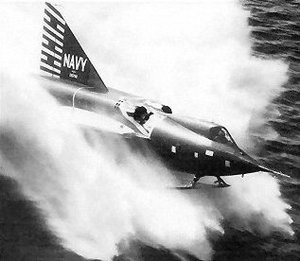F2Y Sea Dart
|
|
The Convair F2Y Sea Dart was a unique seaplane fighter aircraft that rode on twin hydro-skis for takeoff. It only flew as a prototype, and never entered production, but it is still the only seaplane to exceed the speed of sound.
Convair_Sea_Dart.jpg
The Sea Dart began as Convair's entry to a 1948 Navy contest for a supersonic interceptor seaplane. There was at the time much scepticism about operating supersonic planes from aircraft carrier decks, which explains why the US Navy ordered so many subsonic fighters at that time. The worry had some foundation, since many supersonic designs of the time required long takeoff rolls and had high approach speeds, and were not very stable and easy to control - all factors that were troublesome on a carrier.
Convair's proposal gained an order for two prototypes in late 1951. The aircraft was to be a delta-winged fighter with a watertight hull with twin retractable hydro-skis for takeoff and landing. When stationary or moving slowly in the water, the Sea Dart floated with the trailing edge of the wings touching the water. The skis were not extended until the aircraft reached about 10 mph (16 km/h) during its takeoff run.
12 production aircraft were ordered before a prototype had even flown. No armament was ever fitted to any Sea Dart built, but the plan was to arm the production aircraft with four 20 mm cannon and a battery of folding-fin unguided rockets. Four of this order were redesignated as service test planes, and an additional eight production planes were soon ordered as well.
Power was to be a pair of afterburning Westinghouse XJ46-WE-02 turbojets, fed from intakes mounted high up above the wings to avoid ingesting spray. These engines were not ready for the prototypes and twin Westinghouse J34-WE-32 engines of just over half the power were installed. The aircraft was built in Convair's San Diego facility at Lindbergh Field and was taken to San Diego Bay for testing. On January 14, 1953 the aircraft inadvertently made its first short flight during what was supposed to be a fast taxi run; its official maiden flight was on April 9.
The underpowered engines made the plane sluggish, and the hydro-skis were not as successful as hoped; they created violent vibration during takeoff and landing, despite the shock-absorbing oleo legs they were extended on. Work on the skis and oleo legs improved this situation somewhat, but they could not cure the sluggish performance. The Sea Dart proved incapable of supersonic speed in level flight with those engines; not helping was its pre-area rule shape, which meant higher transonic drag.
The second prototype was cancelled, so the first service test aircraft was next to build and fly. This one was fitted with the J46 engines, but they performed below specification. However, speeds in excess of Mach 1 were attained in a shallow dive with this aircraft, making it the only supersonic seaplane to date. This plane disintegrated in mid-air during a demonstration to Navy officials and the press, killing the pilot.
Even before that, the Navy had been losing interest (problems with supersonic fighters on carrier decks having been overcome) and the crash relegated the Sea Dart program to experimental status. All production planes were cancelled, though the remaining three service test aircraft were completed. The two final examples never flew.
The sole prototype was fitted with an experimental single-ski configuration which proved to be rather more successful, while the second service test aircraft trialled (unsuccessfully) a new twin-ski design. Testing with several other experimental ski configurations continued with the prototype through 1957, after which it was placed into storage.
All four remaining Sea Darts survive to this day. The prototype is awaiting restoration for the Smithsonian Institution, and is in bad shape. The others are at the San Diego Aerospace Museum, the Wings of Freedom Air and Space Museum at Willow Grove, Pennsylvania, and at the Lakeland, Florida airport.
Oddly, even though it was long out of service by that time, the Sea Dart was assigned the designation F-7 under the 1962 unified aircraft designation system.
| Related content | |
|---|---|
| Similar aircraft | Saunders-Roe SR.A/1 |
| Designation series (pre-1962) | FY - F2Y |
| Designation series (post-1962) | F-4 - F-5 - F-6 - F-7 - F-8 - F-9 - F-10 |
| Related lists | List of military aircraft of the United States - List of flying boats and seaplanes |
|
Lists of Aircraft | Aircraft manufacturers | Aircraft engines | Aircraft engine manufacturers Airports | Airlines | Air forces | Aircraft weapons | Missiles | Timeline of aviation |

